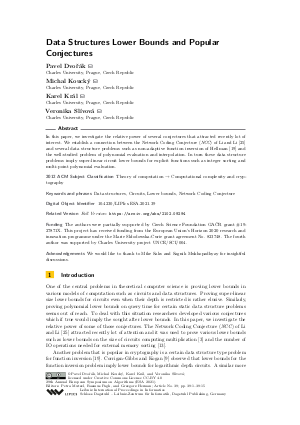LIPIcs.ESA.2021.39.pdf
- Filesize: 0.78 MB
- 15 pages

 Creative Commons Attribution 4.0 International license
Creative Commons Attribution 4.0 International license

In this paper, we investigate the relative power of several conjectures that attracted recently lot of interest. We establish a connection between the Network Coding Conjecture (NCC) of Li and Li [Li and Li, 2004] and several data structure problems such as non-adaptive function inversion of Hellman [M. Hellman, 1980] and the well-studied problem of polynomial evaluation and interpolation. In turn these data structure problems imply super-linear circuit lower bounds for explicit functions such as integer sorting and multi-point polynomial evaluation.

















Feedback for Dagstuhl Publishing